Unit - 2
Looping Statements and Array
Q1) Define loops?
A1) The looping can be defined as repeating the same process multiple times until a specific condition satisfies. There are three types of loops used in the C language.
Why use loops in C language?
The looping simplifies the complex problems into the easy ones. It enables us to alter the flow of the program so that instead of writing the same code again and again, we can repeat the same code for a finite number of times. For example, if we need to print the first 10 natural numbers then, instead of using the printf statement 10 times, we can print inside a loop which runs up to 10 iterations.
Advantage of loops in C
1) It provides code reusability.
2) Using loops, we do not need to write the same code again and again.
3) Using loops, we can traverse over the elements of data structures (array or linked lists).
Types of C Loops
There are three types of loops as given below:
- Do while
- While
- For
Q2) What is for loops, also write any example?
A2) For loop
The for loop in C language is used to iterate the statements or a part of the program several times. It is frequently used to traverse the data structures like the array and linked list.
Syntax of for loop in C
The syntax of for loop in c language is given below:
- For(Expression 1; Expression 2; Expression 3){
- //code to be executed
- }
Flowchart of for loop in C
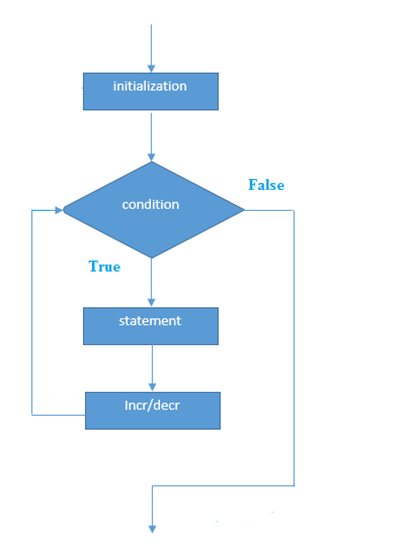
C for loop Examples
Let's see the simple program of for loop that prints table of 1.
- #include<stdio.h>
- Int main(){
- Int i=0;
- For(i=1;i<=10;i++){
- Printf("%d \n",i);
- }
- Return 0;
- }
Output
1
2
3
4
5
6
7
8
9
10
Q3) Describe while loop?
A3) While loop
While loop is also known as a pre-tested loop. In general, a while loop allows a part of the code to be executed multiple times depending upon a given boolean condition. It can be viewed as a repeating if statement. The while loop is mostly used in the case where the number of iterations is not known in advance.
Syntax of while loop in C language
The syntax of while loop in c language is given below:
- While(condition){
- //code to be executed
- }
Flowchart of while loop in C

Example of the while loop in C language
Let's see the simple program of while loop that prints table of 1.
- #include<stdio.h>
- Int main(){
- Int i=1;
- While(i<=10){
- Printf("%d \n",i);
- i++;
- }
- Return 0;
- }
Output
1
2
3
4
5
6
7
8
9
10
Q4) Write a program to print a table for the given number using while loop in C?
A4) Program
- #include<stdio.h>
- Int main(){
- Int i=1,number=0,b=9;
- Printf("Enter a number: ");
- Scanf("%d",&number);
- While(i<=10){
- Printf("%d \n",(number*i));
- i++;
- }
- Return 0;
- }
Output
Enter a number: 50
50
100
150
200
250
300
350
400
450
500
Enter a number: 100
100
200
300
400
500
600
700
800
900
1000
Q5) Explain Do while loop with any example?
A5) The do while loop is a post tested loop. Using the do-while loop, we can repeat the execution of several parts of the statements. The do-while loop is mainly used in the case where we need to execute the loop at least once. The do-while loop is mostly used in menu-driven programs where the termination condition depends upon the end user.
Do while loop syntax
The syntax of the C language do-while loop is given below:
- Do{
- //code to be executed
- }while(condition);
Example 1
- #include<stdio.h>
- #include<stdlib.h>
- Void main ()
- {
- Char c;
- Int choice,dummy;
- Do{
- Printf("\n1. Print Hello\n2. Print Javatpoint\n3. Exit\n");
- Scanf("%d",&choice);
- Switch(choice)
- {
- Case 1 :
- Printf("Hello");
- Break;
- Case 2:
- Printf("Javatpoint");
- Break;
- Case 3:
- Exit(0);
- Break;
- Default:
- Printf("please enter valid choice");
- }
- Printf("do you want to enter more?");
- Scanf("%d",&dummy);
- Scanf("%c",&c);
- }while(c=='y');
- }
Output
1. Print Hello
2. Print Javatpoint
3. Exit
1
Hello
Do you want to enter more?
y
1. Print Hello
2. Print Javatpoint
3. Exit
2
Javatpoint
Do you want to enter more?
n
Flowchart of do while loop
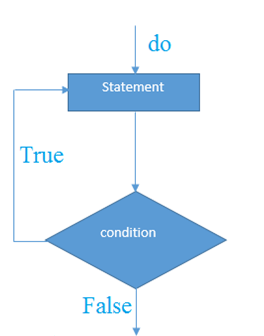
Q6) What are the differences between while and do while loop?
A6) Difference between while and do while loop
While | Do While |
It initially checks the condition before executing the statement. | This loop will run the statement(s) at least once before checking the condition. |
Before beginning the body of a loop, the while loop allows for the initialization of counter variables. | The do while loop allows you to set counter variables before and after the loop starts. |
It's a loop with an entry control. | It's a loop with a controlled exit. |
A semicolon is not required at the end of a while condition. | At the end of the while condition, we need to add a semicolon. |
In the case of a single statement, brackets are required. | Brackets are required at all times. |
The condition is given at the start of the loop in this loop. | After the block has been executed, the loop condition is defined. |
If the condition is false, the statement can be executed zero times. | The statement is run at least once. |
Syntax: While (condition) { Statements; // loop body } | Syntax: Do{ Statements; //loop body } while (condition); |
Q7) What are break statements?
A7) Break statement
The break is a keyword in C which is used to bring the program control out of the loop. The break statement is used inside loops or switch statement. The break statement breaks the loop one by one, i.e., in the case of nested loops, it breaks the inner loop first and then proceeds to outer loops. The break statement in C can be used in the following two scenarios:
- With switch case
- With loop
Syntax:
- //loop or switch case
- Break;
Flowchart of break in c
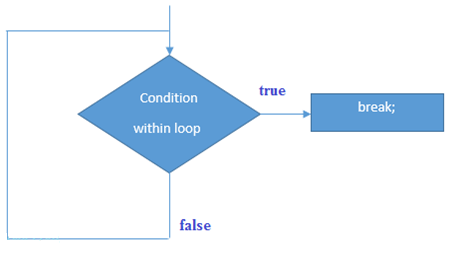
Example
- #include<stdio.h>
- #include<stdlib.h>
- Void main ()
- {
- Int i;
- For(i = 0; i<10; i++)
- {
- Printf("%d ",i);
- If(i == 5)
- Break;
- }
- Printf("came outside of loop i = %d",i);
- }
Output
0 1 2 3 4 5 came outside of loop i = 5
Q8) Write about Continue statement?
A8) The continue statement in C language is used to bring the program control to the beginning of the loop. The continue statement skips some lines of code inside the loop and continues with the next iteration. It is mainly used for a condition so that we can skip some code for a particular condition.
Syntax:
- //loop statements
- Continue;
- //some lines of the code which is to be skipped
Continue statement example 1
- #include<stdio.h>
- Void main ()
- {
- Int i = 0;
- While(i!=10)
- {
- Printf("%d", i);
- Continue;
- i++;
- }
- }
Output
Infinite loop
Q9) Write the difference between break and continue statements?
A9) Difference between Break and Continue statements
Parameters | Break Statement in C | Continue Statement in C |
Loop Construct | This statement lets a user exit from an overall loop construct. | It does not let a user make an exit from an overall loop construct. |
Switch and Loop Statement | One can easily use the break statement along with the switch statement. You can also use it within the for loop, do-while loop, and the while loop. It means that break can easily occur in both loop and switch. | You cannot use the continue statement with the switch statement. Still, you can use it within the for loop, do-while loop, and the while loop. It means that continue can only occur in the loop and not switch. |
Control | The control exits immediately from a loop construct as soon as it encounters the break statement. | As soon as the control encounters the continue statement, it passes automatically from the very beginning of a loop statement. |
Function | The break statement causes a loop or a switch to terminate a case at the very moment of its execution. It means that a switch or a loop would end abruptly as soon as they encounter a break. | The continue statement doesn’t cause a loop termination- but leads it into its next iteration. It means that a loop will execute all of its iterations even if it encounters a continue statement. We use the continue statement to skip those statements that appear after the continue in a loop. |
Syntax | You can denote it as: Break; | You can denote it as: Continue; |
Q10) Explain infinite loop?
A10) Infinite loop
An infinite loop is a looping construct that does not terminate the loop and executes the loop forever. It is also called an indefinite loop or an endless loop. It either produces a continuous output or no output.
When to use an infinite loop
An infinite loop is useful for those applications that accept the user input and generate the output continuously until the user exits from the application manually. In the following situations, this type of loop can be used:
● All the operating systems run in an infinite loop as it does not exist after performing some task. It comes out of an infinite loop only when the user manually shuts down the system.
● All the servers run in an infinite loop as the server responds to all the client requests. It comes out of an indefinite loop only when the administrator shuts down the server manually.
● All the games also run in an infinite loop. The game will accept the user requests until the user exits from the game.
We can create an infinite loop through various loop structures. The following are the loop structures through which we will define the infinite loop:
● For loop
● While loop
● Do-while loop
● Go to statement
● C macros
Q11) What is an array?
A11) Array
An array is defined as the collection of similar type of data items stored at contiguous memory locations. Arrays are the derived data type in C programming language which can store the primitive type of data such as int, char, double, float, etc. It also has the capability to store the collection of derived data types, such as pointers, structure, etc. The array is the simplest data structure where each data element can be randomly accessed by using its index number.
C array is beneficial if you have to store similar elements. For example, if we want to store the marks of a student in 6 subjects, then we don't need to define different variables for the marks in the different subject. Instead of that, we can define an array which can store the marks in each subject at the contiguous memory locations.
By using the array, we can access the elements easily. Only a few lines of code are required to access the elements of the array.
Properties of Array
The array contains the following properties.
● Each element of an array is of same data type and carries the same size, i.e., int = 4 bytes.
● Elements of the array are stored at contiguous memory locations where the first element is stored at the smallest memory location.
● Elements of the array can be randomly accessed since we can calculate the address of each element of the array with the given base address and the size of the data element.
Advantage of C Array
1) Code Optimization: Less code to the access the data.
2) Ease of traversing: By using the for loop, we can retrieve the elements of an array easily.
3) Ease of sorting: To sort the elements of the array, we need a few lines of code only.
4) Random Access: We can access any element randomly using the array.
Declaration of C Array
We can declare an array in the c language in the following way.
Data_type array_name[array_size];
Now, let us see the example to declare the array.
Int marks[5];
Q12) What are the features of arrays?
A12) Features of Array
● A variable that can store a fixed-size collection of elements of the same data type is called an array.
● You can randomly access the elements of an array. You can also determine the address of each array element.
● The array's elements are stored in contiguous memory regions.
● The pointer points to the first memory block in the array name's memory block.
● An array can be an integer, character, or float data type that is only initialized once during the definition process.
● An array's individual elements can be changed without affecting the rest of the array.
● The index number can be used to distinguish all elements in an array.
Q13) Write a program to print the largest and second largest element of the array?
A13)
- #include<stdio.h>
- Void main ()
- {
- Int arr[100],i,n,largest,sec_largest;
- Printf("Enter the size of the array?");
- Scanf("%d",&n);
- Printf("Enter the elements of the array?");
- For(i = 0; i<n; i++)
- {
- Scanf("%d",&arr[i]);
- }
- Largest = arr[0];
- Sec_largest = arr[1];
- For(i=0;i<n;i++)
- {
- If(arr[i]>largest)
- {
- Sec_largest = largest;
- Largest = arr[i];
- }
- Else if (arr[i]>sec_largest && arr[i]!=largest)
- {
- Sec_largest=arr[i];
- }
- }
- Printf("largest = %d, second largest = %d",largest,sec_largest);
- }
Q14) Describe one dimensional array?
A14) One dimensional Array
A one-dimensional array is a group of elements having the same datatype and same name. Individual elements are referred to using common name and unique index of the elements.
The simplest form of an array is one-dimensional-array. The array itself is given name and its elements are referred to by their subscripts. In , an array is denoted as follows:
Array_name[array_size]
Where size specifies the number of elements in the array and the subscript (also called index) value ranges from 0 through size-1.
Declare One Dimensional Array
Here is the general form to declare one dimensional array in
Data_typearray_name[array_size];
Here, data_type is any valid data type, array_name is the name of the array, and array_size is the size of array. Here is an example, declaring an array named arr of int type, having maximum element size of 10 elements
Intarr[10];
Initialize One Dimensional Array
Here is the general form to initialize values to one dimensional array
Data_typearray_name[array_size] = {comma_separated_element_list};
Here is an example, declaring and initializing values to the array name arr of type int, containing 10 elements
Intarr[10] = {1, 2, 3, 4, 5, 6, 7, 8, 9, 10};
One Dimensional Array Example
Here are some example program, demonstrating one dimensional array
/*One Dimensional Array */
#include<iostream.h>
#include<conio.h>
Void main()
{
Clrscr();
Intarr[5] = {1, 2, 3, 4, 5};
Inti;
For(i=0; i<5; i++)
{
Cout<<"arr["<<i<<"] = "<<arr[i]<<"\n";
}
Getch();
}
Here is the sample output of this program:
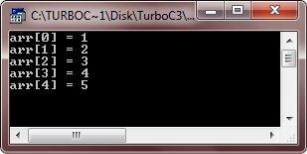
Q15) Write any program to demonstrate a one dimensional array?
A15) Program
#include<iostream.h>
#include<conio.h>
Void main()
{
Clrscr();
Intarr[5];
Inti, position, index;
Cout<<"Enter 5 array elements: ";
For(i=0; i<5; i++)
{
Cin>>arr[i];
}
Cout<<"\nIndex\t\tPosition";
For(i=0; i<5; i++)
{
Cout<<"\n";
Cout<<i<<" = "<<arr[i]<<"\t\t"<<i+1<<" = "<<arr[i+1];
}
Cout<<" (Garbage value/not of array)";
Cout<<"\n\nImportant - Array element can only be accessed by indexing the array\n";
Cout<<"Note - Array index always starts from 0";
Getch();
}
Below is the sample run of this program:
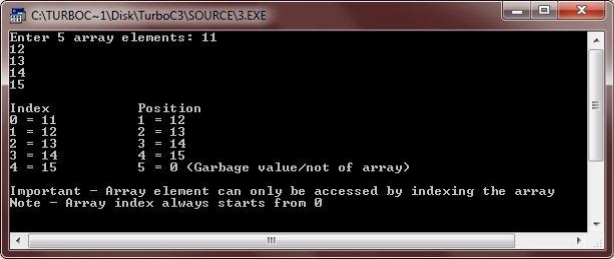
Q16) Explain two dimensional arrays with example?
A16) Two dimensional array
The two-dimensional array can be defined as an array of arrays. The 2D array is organized as matrices which can be represented as the collection of rows and columns. However, 2D arrays are created to implement a relational database lookalike data structure. It provides ease of holding the bulk of data at once which can be passed to any number of functions wherever required.
Declaration of two dimensional Array in C
The syntax to declare the 2D array is given below.
Data_type array_name[rows][columns];
Consider the following example.
Int twodimen[4][3];
Here, 4 is the number of rows, and 3 is the number of columns.
Initialization of 2D Array in C
In the 1D array, we don't need to specify the size of the array if the declaration and initialization are being done simultaneously. However, this will not work with 2D arrays. We will have to define at least the second dimension of the array. The two-dimensional array can be declared and defined in the following way.
Int arr[4][3]={{1,2,3},{2,3,4},{3,4,5},{4,5,6}};
Two-dimensional array example in C
- #include<stdio.h>
- Int main(){
- Int i=0,j=0;
- Int arr[4][3]={{1,2,3},{2,3,4},{3,4,5},{4,5,6}};
- //traversing 2D array
- For(i=0;i<4;i++){
- For(j=0;j<3;j++){
- Printf("arr[%d] [%d] = %d \n",i,j,arr[i][j]);
- }//end of j
- }//end of i
- Return 0;
- }
Output
Arr[0][0] = 1
Arr[0][1] = 2
Arr[0][2] = 3
Arr[1][0] = 2
Arr[1][1] = 3
Arr[1][2] = 4
Arr[2][0] = 3
Arr[2][1] = 4
Arr[2][2] = 5
Arr[3][0] = 4
Arr[3][1] = 5
Arr[3][2] = 6
Q17) Write a program to sort elements in a matrix?
A17)
Storing elements in a matrix and printing it.
- #include <stdio.h>
- Void main ()
- {
- Int arr[3][3],i,j;
- For (i=0;i<3;i++)
- {
- For (j=0;j<3;j++)
- {
- Printf("Enter a[%d][%d]: ",i,j);
- Scanf("%d",&arr[i][j]);
- }
- }
- Printf("\n printing the elements ....\n");
- For(i=0;i<3;i++)
- {
- Printf("\n");
- For (j=0;j<3;j++)
- {
- Printf("%d\t",arr[i][j]);
- }
- }
- }
Output
Enter a[0][0]: 56
Enter a[0][1]: 10
Enter a[0][2]: 30
Enter a[1][0]: 34
Enter a[1][1]: 21
Enter a[1][2]: 34
Enter a[2][0]: 45
Enter a[2][1]: 56
Enter a[2][2]: 78
Printing the elements ....
56 10 30
34 21 34
45 56 78
Q18) Define string function?
A18) String functions
Strings are actually a one-dimensional array of characters terminated by a null character '\0'. Thus a null-terminated string contains the characters that comprise the string followed by a null.
The following declaration and initialization create a string consisting of the word "Hello". To hold the null character at the end of the array, the size of the character array containing the string is one more than the number of characters in the word "Hello."
Char greeting[6] = {'H', 'e', 'l', 'l', 'o', '\0'};
If you follow the rule of array initialization then you can write the above statement as follows −
Char greeting[] = "Hello";
Following is the memory presentation of the above defined string in C/C++ −
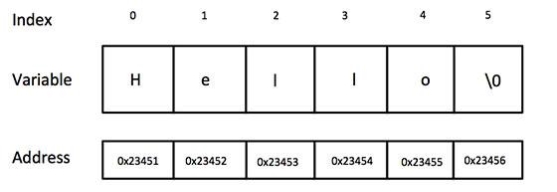
Actually, you do not place the null character at the end of a string constant. The C compiler automatically places the '\0' at the end of the string when it initializes the array. Let us try to print the above mentioned string −
#include <stdio.h>
Int main () {
Char greeting[6] = {'H', 'e', 'l', 'l', 'o', '\0'};
Printf("Greeting message: %s\n", greeting );
Return 0;
}
When the above code is compiled and executed, it produces the following result −
Greeting message: Hello
C supports a wide range of functions that manipulate null-terminated strings −
Sr.No. | Function & Purpose |
1 | Strcpy(s1, s2); Copies string s2 into string s1. |
2 | Strcat(s1, s2); Concatenates string s2 onto the end of string s1. |
3 | Strlen(s1); Returns the length of string s1. |
4 | Strcmp(s1, s2); Returns 0 if s1 and s2 are the same; less than 0 if s1<s2; greater than 0 if s1>s2. |
5 | Strchr(s1, ch); Returns a pointer to the first occurrence of character ch in string s1. |
6 | Strstr(s1, s2); Returns a pointer to the first occurrence of string s2 in string s1. |
Q19) Write a program to demonstrate string functions?
A19) String functions
#include <stdio.h>
#include <string.h>
Int main () {
Char str1[12] = "Hello";
Char str2[12] = "World";
Char str3[12];
Int len ;
/* copy str1 into str3 */
Strcpy(str3, str1);
Printf("strcpy( str3, str1) : %s\n", str3 );
/* concatenates str1 and str2 */
Strcat( str1, str2);
Printf("strcat( str1, str2): %s\n", str1 );
/* total length of str1 after concatenation */
Len = strlen(str1);
Printf("strlen(str1) : %d\n", len );
Return 0;
}
When the above code is compiled and executed, it produces the following result −
Strcpy( str3, str1) : Hello
Strcat( str1, str2): HelloWorld
Strlen(str1) : 10
Q20) Write the difference between one dimensional and two dimensional arrays?
A20) Difference between one dimensional and two dimensional array
Parameters | One-Dimensional Array | Two-Dimensional Array |
Basics | A one-dimensional array stores a single list of various elements having a similar data type. | A two-dimensional array stores an array of various arrays, or a list of various lists, or an array of various one-dimensional arrays. |
Representation | It represents multiple data items in the form of a list. | It represents multiple data items in the form of a table that contains columns and rows. |
Dimensions | It has only one dimension. | It has a total of two dimensions. |
Parameters of Receiving | One can easily receive it in a pointer, an unsized array, or a sized array. | The parameters that receive it must define an array’s rightmost dimension. |
Total Size (in terms of Bytes) | Total number of Bytes = The size of array x the size of array variable or datatype. | Total number of Bytes = The size of array visible or datatype x the size of the second index x the size of the first index. |